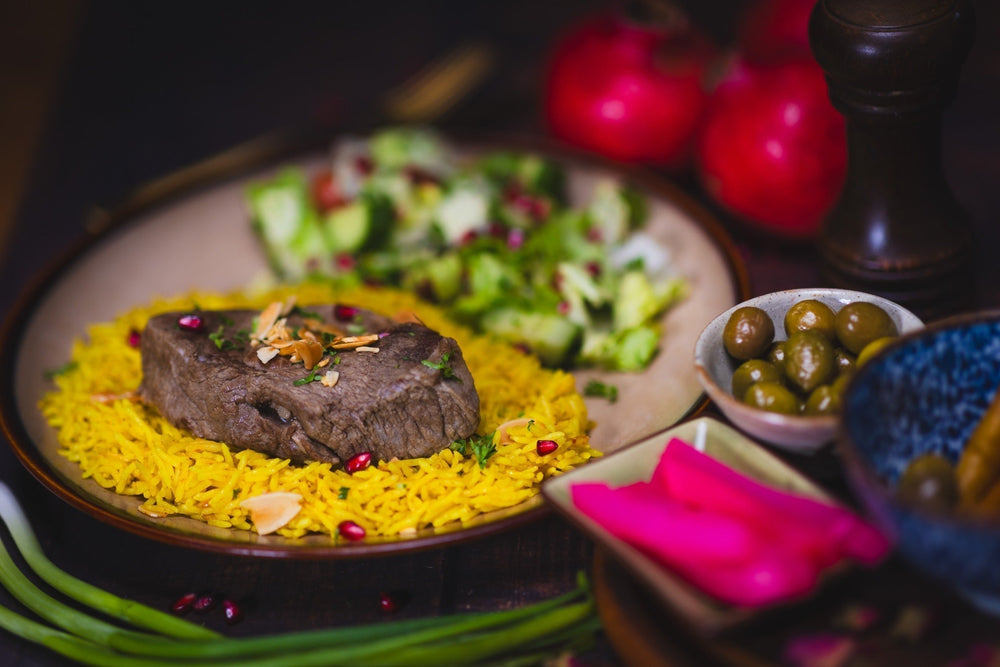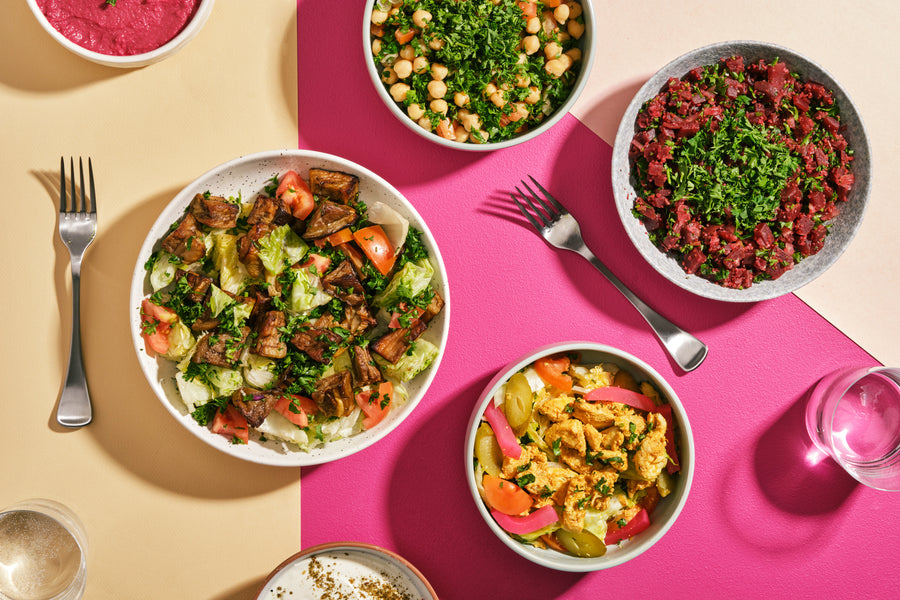A Deep Dive Into Syrian Food: Comprehending Its Cultural Value and Halal Aspects
Syrian food embodies a rich tapestry of cultural impacts and historical narratives. Each dish narrates of community and practice, stressing the relevance of common dishes. The adherence to halal methods not only reflects religions but also forms the identity of Syrian cooking. As global occasions test these culinary traditions, the durability of this food continues to be a centerpiece of cultural conservation. What exists behind the tastes that define this sustaining heritage?
The Historical Origins of Syrian Cuisine
Syrian cuisine has actually developed over centuries, its historical roots are deeply intertwined with the region's diverse cultural influences. Situated at the crossroads of numerous civilizations, Syria has actually taken in cooking techniques from the Phoenicians, Greeks, Romans, and Ottomans, among others. This abundant tapestry of history has added to a cuisine defined by a blend of flavors, seasonings, and cooking methods. The fertile lands of the area have actually also played a crucial function, supplying a wealth of grains, fruits, and vegetables that develop the foundation of numerous dishes. The intro of brand-new ingredients through profession and occupation better improved the cooking landscape, allowing for the growth of distinct regional specializeds. Furthermore, the influence of surrounding countries has led to a dynamic exchange of cooking concepts, strengthening Syria's position as a substantial player in the more comprehensive context of Center Eastern gastronomy.

Typical Syrian Recipes and Their Cultural Importance
Typical Syrian recipes are not only cooking staples yet likewise carry deep social importance, showing the nation's abundant heritage. Legendary dishes, usually prepared throughout festive occasions, function as a way of unifying areas and households. These meals personify the flavors of Syria while reinforcing social bonds with shared parties and practices.
Iconic Syrian Staples
When exploring the rich tapestry of Syrian cuisine, one discovers a selection of iconic dishes that not only entice the taste but likewise symbolize the nation's social heritage. Amongst these staples, Kabsa stands apart as an aromatic rice dish, frequently skilled with seasonings like saffron and cardamom, symbolizing friendliness. Fattoush, a vivid salad made with blended eco-friendlies and crispy bread, mirrors the significance of fresh components in Syrian cooking. Muhammara, a spicy dip made from peppers and walnuts, showcases the abundant tastes particular of the region. Furthermore, Kibbeh, a recipe made from bulgur and minced meat, is usually considered a nationwide prize, representing common gatherings. Each dish narrates, connecting individuals to their origins and customs.
Joyful Meal Customs
Syrian joyful meal customs are rich with significance and value, as households gather to celebrate essential celebrations with the sharing of precious dishes. Meals commonly showcase a selection of standard foods, with recipes like mansaf, kibbeh, and tabbouleh taking spotlight. Each meal carries social history; as an example, kibbeh, made from bulgur and minced meat, stands for friendliness and wealth. During Ramadan and Eid, households prepare unique sweets such as maamoul, signifying joy and unity. These celebrations cultivate neighborhood bonds, as sharing a meal represents love and togetherness. The preparation and enjoyment of these recipes reflect Syria's diverse cooking heritage, linking family personalizeds and regional impacts, therefore improving the joyful experience and preserving social identification.
The Duty of Household and Neighborhood in Syrian Food Culture
Food acts as an essential thread that weaves with each other family members and neighborhood in Syrian society. Meals are typically public experiences, where households gather around a table to share conventional meals that reflect their heritage. The preparation of food is a public task, with generations functioning side by side, passing down dishes and food preparation methods. This technique strengthens familial bonds and fosters a sense of belonging within the community.Special occasions and religious events better highlight the value of food in Syrian culture. Throughout these events, families prepare sophisticated dishes that offer not just to nurture but likewise to express love and friendliness. The act of sharing food signifies unity and assistance among buddies and neighbors, enhancing social connections. Through these shared culinary experiences, Syrians grow a strong identity rooted in their rich cultural background, illustrating how food transcends plain nourishment to become a critical component of their social material.
Halal Practices in Syrian Food Preparation
In the context of public dishes and family members gatherings, halal techniques play a considerable function in Syrian food preparation. These practices come from Islamic nutritional laws, making certain that food is ready and eaten in a fashion that lines up with faiths. For lots of Syrian families, adherence to halal principles influences numerous aspects of dish preparation, from sourcing components to cooking methods.Animals utilized for meat should be butchered according to certain guidelines, highlighting gentle treatment and invoking the name of Allah. In addition, cross-contamination with non-halal items is very carefully stayed clear of in both home kitchens and commercial establishments.This commitment to halal not only reflects spiritual dedication yet likewise cultivates a feeling of neighborhood, as households frequently come with each other to share meals that honor these practices - Brunch Kitsilano Vancouver BC. Subsequently, halal methods are deeply woven right into the textile of Syrian cooking society, shaping both daily life and festive celebrations
Ingredients That Define Syrian Flavors

The significance of Syrian cuisine is shaped by a harmonious mix of vital seasonings and herbs that improve its distinctive tastes. Conventional food preparation techniques better boost these ingredients, showcasing the rich cooking heritage of the area. An overview of important active ingredients exposes the foundational duty they play in creating authentic Syrian recipes.
Secret Spices and Natural Herbs
A vibrant tapestry of tastes identifies Syrian cuisine, with key spices and natural herbs playing a check these guys out crucial duty in defining its essence. Noticeable among these are coriander, cumin, and sumac, which provide deepness and warmth to various meals. Cumin, with its nutty fragrance, commonly boosts stews and barbequed meats, while coriander adds a citrusy note to salads and dips. Sumac, known for its tangy flavor, brightens meals and is frequently sprayed over fattoush or kebabs. Furthermore, cinnamon and allspice provide a refined sweetness, typically found in both wonderful and full-flavored prep work. Fresh natural herbs like dill, mint, and parsley are likewise essential, providing a ruptured of freshness and balancing the rich, intricate tastes that make Syrian cuisine one-of-a-kind.
Typical Cooking Methods
Food preparation techniques in Syrian food reflect an ingrained practice that enhances the flavors of its active ingredients. Approaches such as slow-cooking and braising are frequently employed, permitting natural herbs and flavors to blend wonderfully with meats and vegetables. Grilling, particularly over charcoal, gives a great smoky splendor to dishes like kebabs, while steaming is commonly made use of for rice, preserving its structure and preference. In addition, sautéing is preferred for preparing aromatic bases, typically beginning with onions and garlic to develop depth. Fermentation plays a role in creating special flavors, obvious in meals like pickled veggies. These techniques not only highlight the quality of ingredients however also symbolize the common spirit of cooking, bringing family additional resources members with each other around shared meals steeped in custom.
Crucial Active Ingredients Summary
While discovering Syrian cuisine, one rapidly discovers that essential active ingredients play a crucial function in defining its one-of-a-kind tastes. Olive oil, a staple, gives splendor and depth, commonly functioning as a base for several dishes. Fresh herbs, such as mint, parsley, and cilantro, add vivid aromas and tastes, boosting the total experience (Brunch Kitsilano Vancouver BC). Spices like cumin, coriander, and cinnamon are frequently made use of, including warmth and complexity to dishes. Additionally, Syrian cuisine greatly integrates grains, particularly bulgur and rice, which work as basic parts in various dishes. Pulses, particularly lentils and chickpeas, offer both nourishment and texture. Together, these ingredients produce the unified balance that characterizes Syrian meals, reflecting the country's abundant cooking heritage and social relevance
The Influence of Battle on Syrian Culinary Practices
Although the battle in Syria has actually functioned devastation throughout the country, its influence on cooking practices exposes an intricate interplay of resilience and adjustment. As communities encountered variation, standard dishes were customized due to the shortage of sources and active ingredients. Households usually rely upon in your area available produce, incorporating new tastes and methods into their dishes, which resulted in the development of unique interpretations of traditional dishes.Moreover, the battle promoted a spirit of solidarity among displaced cooks and home chefs, that shared their cooking understanding via social media and community kitchen areas. This sharing of dishes not just preserved cultural heritage but additionally produced a sense of belonging among those impacted by the problem. Regardless of the difficulties, the interest for food continues to be a unifying force, enabling individuals to keep their identity and link with their origins, even in expatriation. Syrian cuisine continues to advance amidst hardship, reflecting both an abundant history and modern durability.
Often Asked Inquiries
What Are Common Food Preparation Methods Made Use Of in Syrian Food?
Common food preparation methods in Syrian food consist of cooking, cooking, sautéing, and stewing. These methods improve flavors and appearances, allowing for the creation of varied meals that reflect the area's rich culinary heritage and traditions.
How Has Globalization Influenced Syrian Food?

Are There Vegetarian Options in Traditional Syrian Recipes?
Vegan alternatives prevail in traditional Syrian recipes, featuring components like veggies, chickpeas, and lentils. Popular meals such as Mujadara and Falafel highlight this diversity, fitting various nutritional choices while protecting the rich tastes of the cuisine.
What Beverages Pair Well With Syrian Meals?
Drinks that couple well with Syrian dishes include mint tea, pomegranate juice, and ayran - Brunch Kitsilano Vancouver BC. These beverages enhance the tastes of traditional recipes, enhancing the dining experience while offering stimulating contrasts to the rich, tasty preferences
Exactly How Do Syrians Commemorate Food During Holidays or Festivals?
Syrians commemorate food during holidays and festivals with sophisticated banquets, try here often including conventional dishes. Household gatherings emphasize sharing meals, symbolizing unity and social heritage, while special deals with and desserts highlight the festive spirit and public pleasure. Conventional Syrian recipes are not just cooking staples but also lug deep cultural relevance, showing the country's rich heritage. When checking out the abundant tapestry of Syrian food, one uncovers a range of iconic recipes that not only tantalize the palate however also embody the country's social heritage. Syrian festive meal practices are rich with importance and relevance, as family members collect to celebrate vital celebrations through the sharing of precious dishes. Cooking methods in Syrian cuisine reflect an ingrained practice that boosts the tastes of its components. Vegan alternatives are widespread in standard Syrian meals, featuring ingredients like veggies, lentils, and chickpeas.